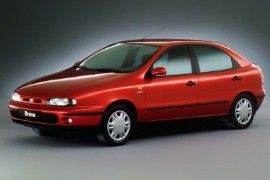FIAT Brava Models/Series Timeline, Specifications & Photos
First production year: 1995
Engines: Gasoline, Diesel
Body style: Hatchback
In 1994 Fiat decided to retire the aging Tipo with two different nameplates: Bravo and Brava. While the Bravo was the sporty-looking three-door hatchback, the Brava was addressed to families with a five-door configuration.
Even though these two vehicles were actually the same versions of the same bodywork, they still managed to catch Europeans' attention after they won the "Car Of The Year" Award. They were penned during the bio-design era, and they showed that in every detail.
With its rounded shapes and flowing lines, the Brava featured a tiny grille at the front, integrated into the hood, sporting the Fiat badge in the middle. Its body-colored plastic bumper with a broad grille in the apron was responsible for providing the cooling area. From its sides, a waved, ascending beltline created a visually mild, non-aggressive presence. After all, it was a family vehicle. The black, unpainted door handles were part of the low-budget scheme. They cost less and were cheaper to replace if needed.
The interior featured two bucket seats at the front covered in fabric, separated by a low center console. Its dashboard was almost entirely made from plastic, with an open storage compartment in front of the passenger. For the driver, Fiat installed an attractive-looking instrument panel with a wide speedometer and two half-dials for the fuel level and the coolant temperature. Depending on the engine and options, a tachometer was also present. At the back, a folding bench expanded the trunk size. Unfortunately, it was not a split-folding system.
Under the hood, Fiat installed a wide engine choice between 80 hp and 113 hp. It also provided a choice of turbodiesel powerplants.
